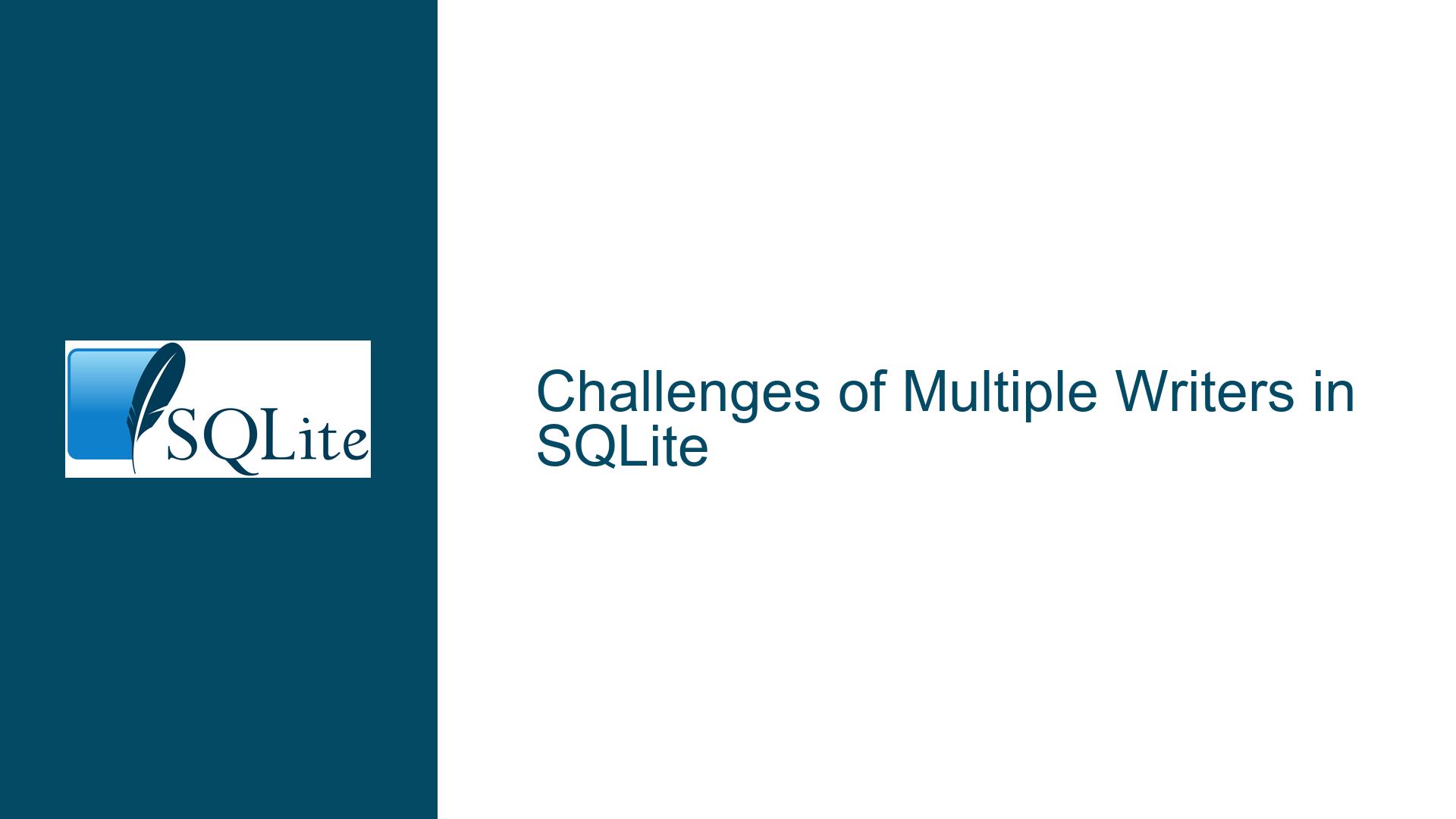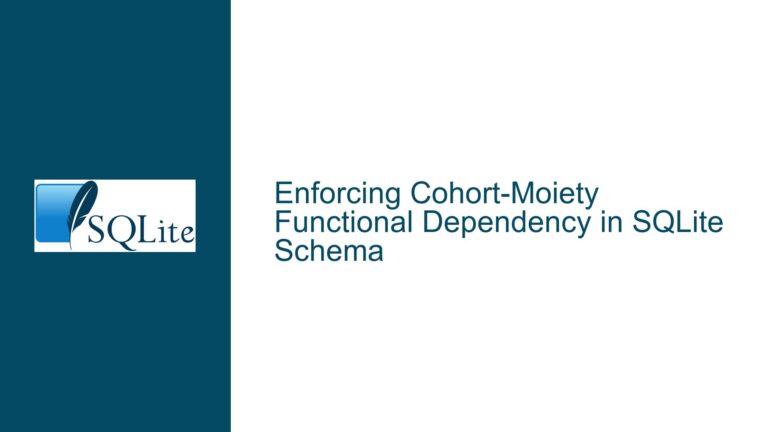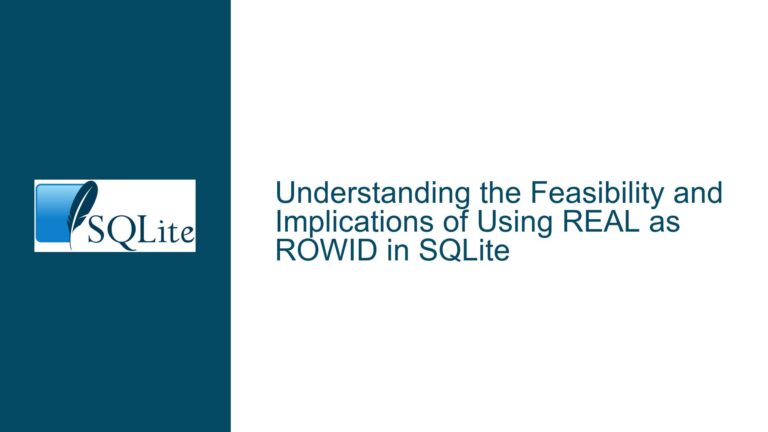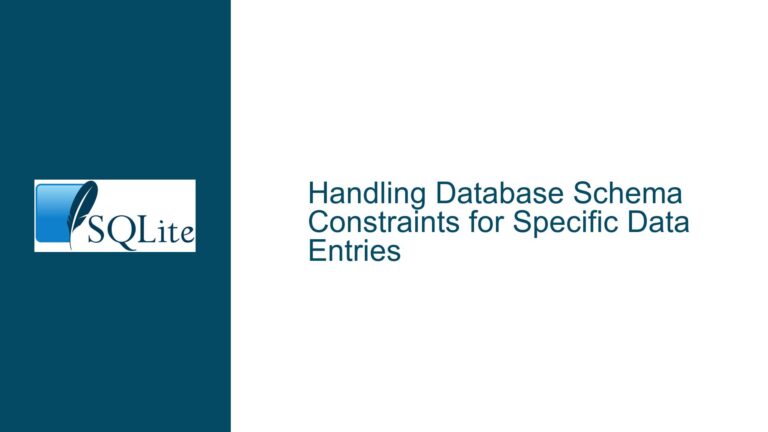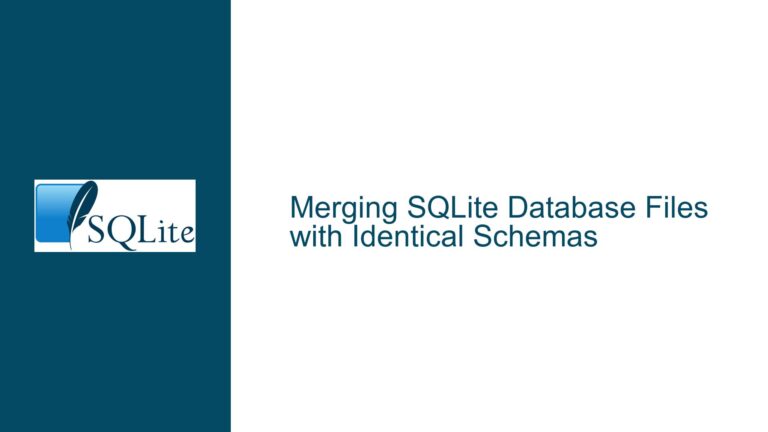Challenges of Multiple Writers in SQLite
Understanding SQLite’s Writer Limitations
SQLite is a widely used embedded database system known for its lightweight nature and simplicity. However, one of the most significant limitations that users encounter is its inability to support multiple concurrent writers. This restriction raises questions, especially among new users who may wonder why a database designed for modern applications cannot accommodate multiple processes writing simultaneously. The discussion in the forum highlights various perspectives on this issue, emphasizing both theoretical and practical considerations.
The core of the problem lies in how SQLite manages data integrity and concurrency. Unlike traditional client-server database management systems that employ sophisticated locking mechanisms, SQLite operates with a simpler file-level locking strategy. This design choice allows for efficient read operations but imposes strict limitations on write operations. When a write operation is initiated, SQLite locks the entire database file to ensure that no other write operations can occur until the first one completes. This approach guarantees data consistency but also leads to contention when multiple writers attempt to access the database simultaneously.
Several forum participants pointed out that even larger relational database management systems (RDBMS) face similar challenges when handling multiple writers. While they may employ advanced locking techniques at various granularities (such as row or field-level locks), the fundamental issue remains: if two independent writers attempt to update the same data concurrently, one must be rolled back to maintain data integrity. The discussion indicates that this principle applies universally across database systems, suggesting that the limitations are not unique to SQLite but rather a common challenge in maintaining ACID (Atomicity, Consistency, Isolation, Durability) properties.
Theoretical propositions were also presented regarding potential solutions to enable multiple writers in SQLite. Some users suggested implementing mechanisms akin to Multi-Version Concurrency Control (MVCC), which allows transactions to occur without locking by maintaining snapshots of data states. However, this approach introduces complexity into SQLite’s architecture and conflicts with its existing design principles. The forum participants noted that SQLite’s original design did not account for multiple concurrent writers since it was primarily intended as an embedded library linked into single applications.
Another significant concern raised in the discussion is backward compatibility with existing SQLite databases. With trillions of SQLite files already in use globally, any changes to the underlying file format or locking mechanisms must ensure that these files remain accessible and functional. This constraint poses a substantial barrier to introducing multi-writer capabilities, as it would require extensive modifications to the current system without compromising existing data integrity.
Furthermore, practical challenges were highlighted regarding how simultaneous writes would be managed in real-time scenarios. For instance, if two processes attempt to write different values to the same field simultaneously, determining which value should prevail becomes problematic. This situation could lead to data corruption and violate ACID principles, undermining the reliability of the database.
In summary, while there are theoretical frameworks that could allow for multiple writers in SQLite, practical considerations such as file-level locking mechanisms, backward compatibility issues, and the fundamental principles of data integrity pose significant challenges. Understanding these limitations is crucial for developers who wish to leverage SQLite effectively within their applications while recognizing when alternative databases may be better suited for high-concurrency environments.
Key Challenges of Supporting Multiple Writers in SQLite
SQLite’s architecture is fundamentally designed to prioritize simplicity and efficiency, particularly in single-user or embedded application contexts. However, this design leads to significant challenges when considering support for multiple concurrent writers. The primary issues stem from SQLite’s file-based locking mechanism, the need for data integrity, and the inherent limitations of its architecture.
File-Level Locking Mechanism
SQLite utilizes a file-level locking system to manage access to the database. This means that when a write operation is initiated, SQLite locks the entire database file. Consequently, only one writer can perform operations at any given time. This approach is inherently efficient for single-threaded applications but becomes a bottleneck in multi-user scenarios where multiple processes may attempt to write simultaneously.
The locking states in SQLite are categorized as follows:
UNLOCKED: No locks are held; neither reading nor writing is permitted.
SHARED: Multiple readers can access the database concurrently, but no write operations can occur.
RESERVED: A process intends to write to the database but must wait for existing readers to finish.
PENDING: A process is waiting for a shared lock to be released so it can obtain an exclusive lock.
EXCLUSIVE: Only one process can hold an exclusive lock, preventing all other operations until the lock is released.
This locking mechanism ensures data integrity but significantly limits concurrency. When multiple writers attempt to write at the same time, they must queue up and wait for their turn, leading to potential performance degradation and increased latency in applications requiring high write throughput.
Data Integrity and ACID Compliance
Another critical challenge in allowing multiple writers is maintaining data integrity and adhering to ACID (Atomicity, Consistency, Isolation, Durability) principles. In a multi-writer scenario, ensuring that transactions do not interfere with one another becomes complex. For instance, if two writers attempt to modify the same record simultaneously without proper isolation mechanisms, it could lead to data corruption or inconsistent states within the database.
To illustrate this point, consider a situation where Writer A updates a record while Writer B simultaneously attempts to update the same record. Without a robust locking mechanism or transaction management system in place, one writer’s changes could overwrite the other’s, resulting in lost updates and violating the consistency aspect of ACID compliance.
SQLite’s design philosophy emphasizes that every transaction must appear as if it were executed serially. This means that even if two transactions are initiated concurrently, they must be processed in a manner that preserves their individual atomicity and consistency. Implementing such a system with multiple concurrent writers would require significant architectural changes and could compromise SQLite’s lightweight nature.
Architectural Limitations
SQLite was originally designed as an embedded database library intended for use within single applications. As such, its architecture does not accommodate multi-threaded or multi-process environments where concurrent writes are common. The lack of built-in support for advanced concurrency control mechanisms—such as Multi-Version Concurrency Control (MVCC)—further restricts its ability to handle multiple writers effectively.
MVCC allows transactions to operate on snapshots of data rather than directly on the underlying data itself. This approach enables higher concurrency by allowing multiple transactions to proceed without waiting for others to complete. However, integrating MVCC into SQLite would require substantial modifications to its core architecture and potentially disrupt backward compatibility with existing databases.
Conclusion
In summary, while enabling multiple writers in SQLite presents an appealing prospect for enhancing concurrency, several fundamental challenges prevent its implementation. The reliance on file-level locking mechanisms creates bottlenecks that hinder performance in multi-writer scenarios. Additionally, maintaining data integrity while adhering to ACID principles complicates the architecture further.
SQLite’s design philosophy prioritizes simplicity and efficiency over complex concurrency controls typically found in larger RDBMS solutions. For applications requiring high levels of concurrent writes, alternative database systems may be more suitable than SQLite due to their inherent capabilities for handling such scenarios effectively.
Effective Strategies for Managing Multiple Writers in SQLite
While SQLite is fundamentally designed to support a single writer at a time, there are several strategies developers can employ to manage write operations effectively within its constraints. These strategies focus on optimizing performance, maintaining data integrity, and utilizing SQLite’s features to mitigate the limitations imposed by its architecture.
Utilizing Write-Ahead Logging (WAL) Mode
One of the most effective ways to enhance concurrency in SQLite is by enabling Write-Ahead Logging (WAL) mode. In this mode, changes are first written to a separate log file before being applied to the main database. This approach allows for concurrent reads and writes, significantly reducing contention between multiple processes.
When WAL mode is enabled, readers do not block writers, which enhances overall performance. The WAL mechanism allows multiple transactions to proceed without waiting for locks to be released. The main advantages of using WAL mode include:
Improved Write Performance: By separating write operations from read operations, WAL mode reduces the likelihood of lock contention, allowing for faster data manipulation.
Increased Concurrency: Multiple readers can access the database simultaneously while a single writer is active, improving throughput in read-heavy applications.
Durability: Transactions are logged in a manner that ensures they can be recovered in case of failures, maintaining data integrity.
To enable WAL mode, the following commands can be executed:
PRAGMA journal_mode = WAL;
PRAGMA synchronous = NORMAL;
These settings ensure that writes are handled efficiently while still providing durability guarantees.
Implementing Transaction Management Techniques
Effective transaction management is crucial for optimizing write operations in SQLite. By wrapping multiple write operations within a single transaction, developers can significantly enhance performance and reduce overhead. This approach minimizes the number of lock acquisitions and releases required during write operations.
For instance, instead of executing individual insert statements separately, developers can group them into a single transaction:
BEGIN TRANSACTION;
INSERT INTO table_name (column1, column2) VALUES (value1, value2);
INSERT INTO table_name (column1, column2) VALUES (value3, value4);
COMMIT;
This technique not only improves performance but also ensures that all changes are treated as a single atomic operation. If any part of the transaction fails, the entire operation can be rolled back, maintaining data consistency.
Leveraging Connection Pooling
Connection pooling is another strategy that can improve write performance in SQLite applications. By reusing existing database connections rather than creating new ones for each transaction, developers can reduce the overhead associated with establishing connections. This approach is particularly beneficial in high-concurrency environments where multiple processes need to access the database frequently.
Connection pooling allows for better resource utilization and faster response times when handling database requests. By managing a pool of active connections, applications can efficiently distribute write requests among available connections while adhering to SQLite’s single-writer rule.
Using BEGIN CONCURRENT for Optimistic Locking
For scenarios where concurrent writes are necessary, developers can explore using the BEGIN CONCURRENT feature available in certain builds of SQLite. This enhancement allows multiple write transactions to proceed simultaneously under specific conditions. When using BEGIN CONCURRENT, locking is deferred until a commit operation is executed.
The key points regarding BEGIN CONCURRENT include:
Optimistic Locking: Transactions are allowed to proceed without immediate locking until they attempt to commit. This approach reduces wait times for writers.
Conflict Detection: During commit operations, SQLite checks for conflicts between transactions. If conflicts are detected—such as attempts to modify the same data—an error is returned (e.g.,
SQLITE_BUSY_SNAPSHOT), prompting developers to handle the situation appropriately.
This feature requires careful implementation and testing but can provide significant benefits in environments where concurrent writes are essential.
Conclusion
While SQLite’s architecture inherently limits it to one writer at a time, several strategies can effectively manage multiple write operations within its constraints. Enabling Write-Ahead Logging (WAL) mode enhances concurrency by allowing simultaneous reads and writes while maintaining data integrity. Implementing robust transaction management techniques and leveraging connection pooling further optimize performance in high-concurrency scenarios.
For applications requiring more extensive write concurrency beyond what SQLite offers natively, considering alternative database systems or architectures may be necessary. However, with careful planning and optimization strategies, developers can maximize SQLite’s capabilities and create efficient applications that meet their needs effectively.
